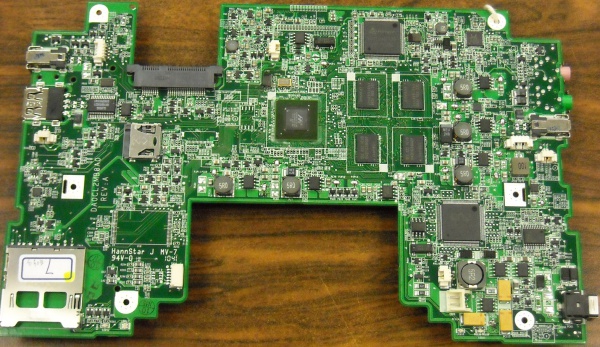XO 1.75 A1
XO-1.75 Laptop Alpha test model, also known as A-test or A1.
Description
The A1 are the first prototypes of the XO-1.75 built. The A1 bring up is happening in late Oct., 2010.
The number of boards obtained will be small, and distribution will be limited to hardware testing and OFW and Linux kernel driver development.
Identification
- Bare circuit board, no case or display
Photographs:
Software Support
XO-1.75 use Q4xxx firmware releases. These will not work on an XO-1 or XO-1.5. For the first time, Open Firmware is provided as part of the Linux image, and the EC firmware is separate. The current firmware release is Q4A05.
It is strongly recommended that you have two sources of power (a charged battery and an external power source) when you upgrade your EC or Open Firmware. Failure to do so may require the use of an SPI programmer to recover your laptop.
Upgrading OFW
Place a recent release of the Q4XYY firmware onto an SD device, and place it in the external SD slot.
Interrupt the OFW boot process by pressing the ESC key.
Type (assuming a q4a05 release):
flash ext:\q4a05.rom
Note: If upgrading from an unofficial Q4A04 release, the "int" and "ext" SD cards may be switched.
Reboot by holding down the power button once this is completed.
Upgrading the EC code
This is currently being debugged. The reliable way of upgrading the EC code involves in-circuit reprogramming of the EC SPI Flash ROM using an SPI programmer. An alternate way exists for recent EC versions using the EC serial port (populated on most motherboards).
The ultimate goal is reprogramming via the host/EC interface.
Upgrading Linux
A Linux image for the A1 is available at http://build.laptop.org/F12-arm/os1/.
Installing from Linux
To install on an XO-1.5, you can run:
zcat os1.img.gz > /dev/hda
Installing from OFW
You will need the .zd version of the OS image. Download it, then:
- Place the image on a USB stick, and insert it into the XO-1.5 laptop's USB port.
- Boot the laptop, pressing the escape key ('X' in upper left hand corner of keyboard) within a few seconds after boot to enter Open Firmware.
- To install onto the internal SD card, type:
fs-update u:\os34.zd
To install an image onto the external SD card, you need to type:
devalias fsdisk ext:0 fs-update u:\os1.zd
Restrictions
There is a list of recommended modifications (ECOs).
Despite the lack of any heat sink at this time, we haven't seen any overheating even in closed units.
Audio Inputs
The audio inputs are messed up. The internal microphone is wired to one channel, and one channel of the external microphone is wired to the other. Despite this, if the microphone is rewired the audio sounds pretty good (using Q4A05 or greater, type "test /audio").
Video Display
The video display is wired incorrectly, giving a pink hue to the video. It grows on you after a while...
There is no good "software cure" for this. At best, a complicated gamma table could minimize the wiring to completely fix the problem (using the unused LSB to contain the actual MSB, wiring it into place). The software team is lobbying for the bits to be manually shifted (6 wires, across pads that are 0.5mm apart!). While this is painful, it appears that it will be the accepted solution to "life through rosy lenses".
SD Flakiness
Versions of OFW up to Q4A05 operate the SD interfaces at 25 MHz unless it is told otherwise:
dev /sd false to avoid-high-speed? dend
Starting with Q4A05A (private release), operation of SD interfaces at 50 MHz is supported.
There are still some problems (#10457) on some motherboards.
USB
Still doesn't work (reliably/at all)
Documentation
Supporting documentation for these boards (all in PDF):
Please note that production boards will likely have different pin mappings and connector locations.
